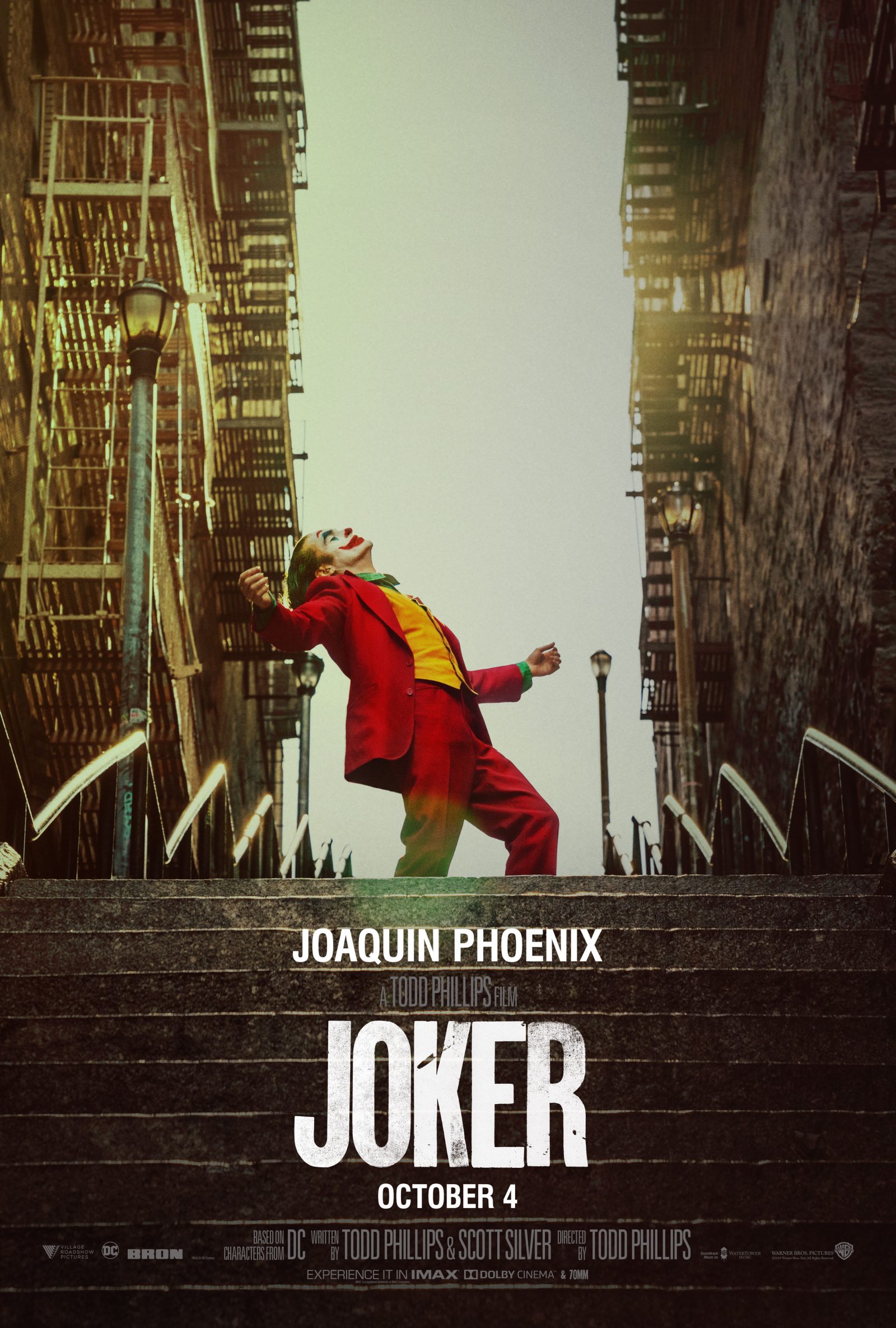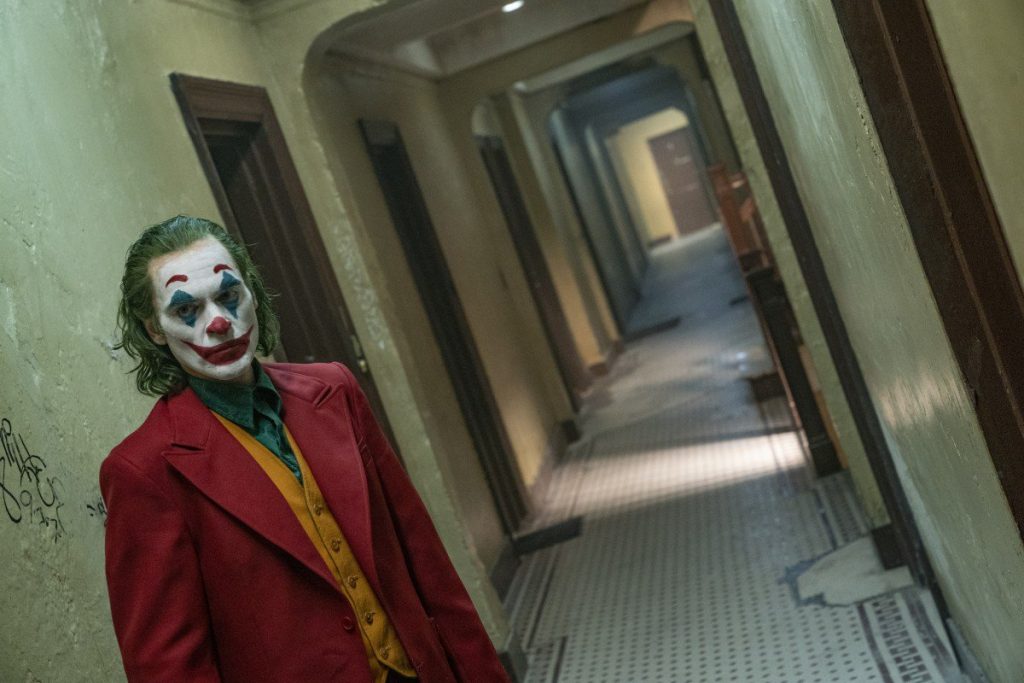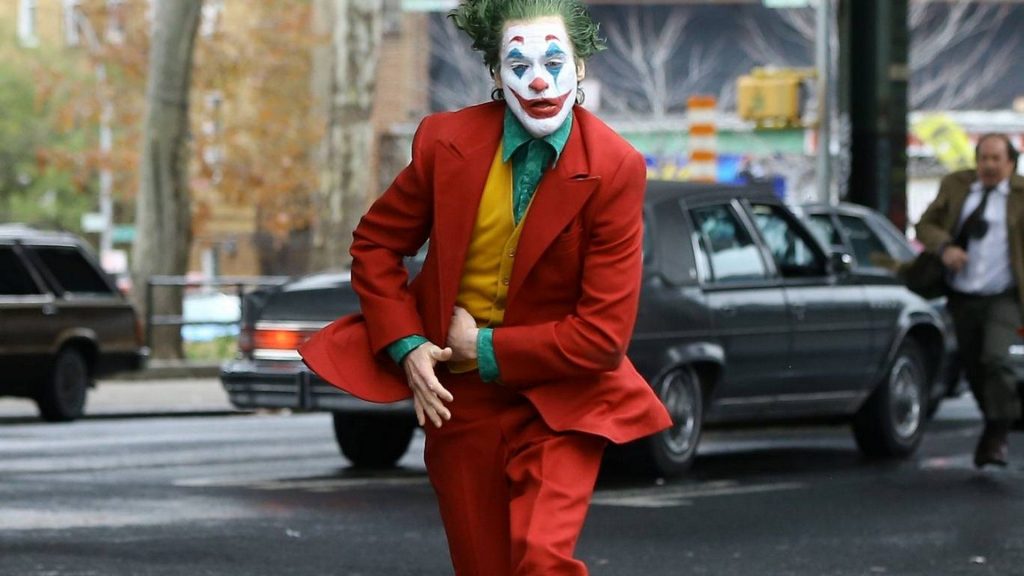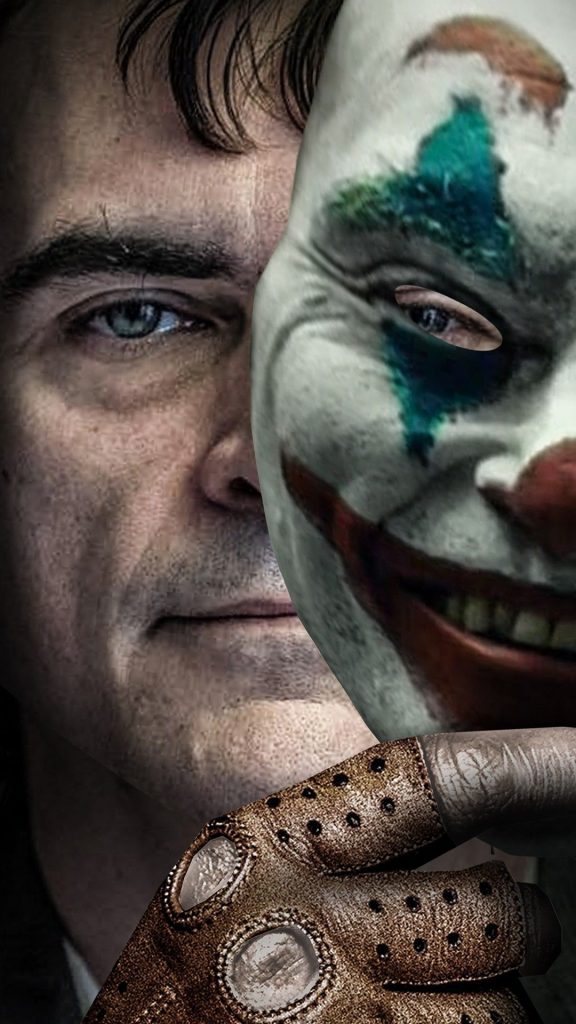 Director: Todd Phillips
Director: Todd Phillips
Cast includes Joaquin Phoenix, Zazie Beetz, Sophie Dumond, Robert De Niro, Marc Maron, Ted Marco and Brett Cullen
Review by Tim Robins, a grumpy old man writes…
The Film: Forever alone in a crowd, failed comedian Arthur Fleck seeks connection as he walks the streets of Gotham City. Arthur wears two masks – the one he paints for his day job as a clown, and the guise he projects in a futile attempt to feel like he’s part of the world around him. Isolated, bullied and disregarded by society, Fleck begins a slow descent into madness as he transforms into the criminal mastermind known as the Joker…
The Review: Before I begin, a message to all dramatists – never, and I mean never, ever, as Joker does, use rats, mutant or otherwise, as a sign of social disintegration, particularly if you are then going to show explore this disintegration by focussing on down trodden ethnic minorities. The trope just has all the wrong conations for anyone who has seen the Nazi propaganda film The Eternal Jew (1940). Juxtaposing rats and crimes or people of Jewish Faith, or African Americans is just a bad idea. It was a bad idea in “The Lights of London” (Jack Ronder’s two-part episode of the BBC post-disaster series The Survivors), in which the regular cast must face the twin perils of hordes of rats and a group led by “Manny”, a Jewish gang boss; and it is a bad idea in Joker, a film full of many such bad ideas.
 The character of the Joker has always been ethnically ‘marked’, although I can’t recall anyone noting this. The character debuted in Batman #1, back in 1940. He wasn’t the first recurring Batman villain: that honour belongs to Dr Death, who foreshadows the Joker’s origin story by being trapped in a laboratory fire that leaves his face hideously scarred or, as the drawing suggests, looking like a green oriental.
The character of the Joker has always been ethnically ‘marked’, although I can’t recall anyone noting this. The character debuted in Batman #1, back in 1940. He wasn’t the first recurring Batman villain: that honour belongs to Dr Death, who foreshadows the Joker’s origin story by being trapped in a laboratory fire that leaves his face hideously scarred or, as the drawing suggests, looking like a green oriental.
At first, the Joker seemed like a welcome change from the relentlessly gothic mad scientists and Fu Manchu types that populated Detective Comics in the early years of the Batman strip. Many of Batman’s nastier opponents such as vampires, werewolves and zombies were to be banned outright by the Comics Code Authority. But while today’s sensibilities may tut tut at the comic strip’s depiction of Orientals, The Joker is overlooked as an ethnic stereotype. As became clearer, at least by 1942, when the strip was better drawn, the Joker’s costume was a zoot suit, a form of dress associated first with African-Americans and then Mexican-Americans. It was garb popular in the 1940s and “typically included bright coloured fabric, long coats that often reached the knees, wide flamboyant shoulders, and ruffled slacks. The arm and ankle areas were often much tighter than the rest of the fabric, giving the whole look a triangular shape”.
By 1943, the “Zoot Suit Riots” in California cemented the clothing’s ties with imputed ethnic criminality, while the clothing’s appeal spread among various ethnic communities. It is not by chance that echoes of the Joker’s appearance can be seen to be echoed in the apparel of Christopher Moltisanti’s in The Sopranos.
The Joker’s relationship to ethnic minorities is certainly an issue in the new movie, but one that is so hazily addressed, I was left unclear as to what the film was trying to say just left feeling it wanted to say something. For a while, after Arthur Fleck (Joaquin Phoenix) leaves his employer, a clowning agency, the only people he seems to encounter in a social service office, in a lift and even on television, are African Americans. Does director Todd Phillips intend this to be a sign of the character’s degradation? Surely not.
And when Fleck encounters and kills middle class drunks on the subway, is the fact that they are White supposed to suggest that the uprising Fleck’s actions incite is a racially based? Even that working class African-Americans have only been waiting for a White man to inspire then (albeit one in clown-face)?
Perhaps it is better not to enquire too closely. The film certainly doesn’t.
 I have to admit that I had to drag myself kicking and screaming to see Joker – and the film lived up to my gloomy expectations. No one should be left alone with this despondent movie, although given the film has made $96 million dollars in its opening “weekend” (five days), the chances of that happening anytime soon seem slight.
I have to admit that I had to drag myself kicking and screaming to see Joker – and the film lived up to my gloomy expectations. No one should be left alone with this despondent movie, although given the film has made $96 million dollars in its opening “weekend” (five days), the chances of that happening anytime soon seem slight.
Joker’s box office success and its rapturous eight-minute standing ovation at the Venice International Film Festival, where the film won the Golden Lion award for ‘Best Film’, suggest the film is not without exemplary qualities, notably Todd Phillips’s direction and the mise-en-scene which evoke 1970s’ film makers’ takes on city life, and Joaquin Phoenix’s sustained performance as Arthur Fleck, the titular ‘Joker’ delivers a performance that embodies all the fun stuff that drama school students love.
Joker has provoked a lot of anxiety. The film was not screened at the Aurora cinema in Colorado where, in 2012, a gun man, John Holmes, walked in to a screening of The Dark Knight Rises, featuring Heath Ledger as The Joker, and killed 12 members of the audience, injuring many more.
Some family members of the victims wrote to Warner Bros noting that, when they learned the studio was presenting the character as a protagonist with a sympathetic origin, it “gave them pause”. The families suggested that Warner Bros should end contributions to political candidates who accept money from the National Rifle Association and to actively lobby for more gun control. This is an entirely understandable reaction by the traumatised families, even though the association with ‘The Joker’ and the actions of Holmes was entirely coincidental.
The belief that Holmes was inspired by the Batman villain was the result of unfounded comments by the New York Police commission at the time of the shooting. And Holmes’ prosecutors did nothing to counter the narrative during the trial, as they felt it aided their case for giving Holmes death sentence.
Later, George Brauchler, the Colorado district attorney who prosecuted Holmes admitted to Vanity Fair that the idea “the crazy-hair-coloured guy who shot up the Batman premiere thought he was the Joker” had, he noted, “No connection to reality.”
Not at all incidentally, a similar misapprehension was at work in the reported link between Chucky 3 and the killing of Jamie Bulger, even though one senior detective on the case noted, “We went through something like 200 titles rented by the Venables family. There were some you or I wouldn’t want to see, but nothing – no scene, or plot, or dialogue – where you could put your finger on the freeze button and say that influenced a boy to go out and commit murder.”
And, before that, the Hungerford Massacre, which was claimed by the press to have been inspired by Rambo: First Blood, although there was no evidence that the killer even owned a video recorder, let alone that he had seen the film.
It seems that such claims are only met with incredulity by academics, who point to poorly conceived experiments and philosophically questionable beliefs that images have an agency all of their own.
 Such fears seemed to have taken hold in the Picturehouse cinema where I watched Joker, because I was greeted with a sign saying that due to increased concern over film piracy, there would be random searches of cinema goers’ bags. Yeah, I am sure that was the reason, because that’s where pirates would store their recording equipment not, for instance, in their pocket.
Such fears seemed to have taken hold in the Picturehouse cinema where I watched Joker, because I was greeted with a sign saying that due to increased concern over film piracy, there would be random searches of cinema goers’ bags. Yeah, I am sure that was the reason, because that’s where pirates would store their recording equipment not, for instance, in their pocket.
Suffice to say, no bags were searched and the screening at one of Brighton’s art house cinemas passed without incident.
None of the above is to say that a film such as The Dark Knight Rises or Joker are not made meaning by members of the audience. For example, a service user of a mental health support line once declared to me, “Everything burns!”. Not for a moment did I think the individual was about to set their perceived enemies on fire, but it was still worth checking to make sure of that. (In the end, they decided that their outlook on life was better represented by Magneto, so there was hope).
Joker also dramatises another kind of social appropriation. I can’t imagine that Alan Moore or David Lloyd ever expected V for Vendetta to strike a resonance with all manner of social protests. But the ‘V’ Guy Fawkes masks have now become an intentionally unsettling feature of demonstrations whether part of, or allied to, or in the spirit of the only group known only as “Annonymous” . The one place I felt Joker touched base with anything real was in the scenes where protesters against White (?) privilege donned Clown masks.
It is ironic that the stunts being pulled by the Extinction Rebellion movement are more akin to something the Joker would come up with than anything seen in this movie – albeit without any of the violence and terror the Clown of Crime has delivered in fiction.
There are critics who have seen the latest on-screen incarnation of The Joker as giving voice to white, male In-Cels (involuntary celibate), but throwing around labels isn’t helpful. More to the point, Joker can’t martial any kind of coherent view about anything.
This being, at time of writing, ‘World Mental Health Day’, it behoves me to say that Joker is desperately clichéd representation of a person with mental health issues. Little seems to have change since the 1950s, let alone the Nineties, when the predominant media image of the mentally ill was as potentially violent, with an emphasis on extreme psychiatric conditions that even then rarely led to violence. I don’t know what conditions Phoenix’s Joker is supposed to have, beyond laughing at inappropriate moments (although the film isn’t consistent about this). What I do know is that the script trades every stigmatising misconception about people with mental health problems.
Here’s what a Mind report (PDF), examining representations of mental health from the early years’ of cinema to the almost present, has to say:
“Film needs drama and conflict to keep audiences engaged, and this means the behaviours of people with mental health problems are more likely to be extreme. If the film features a central character with a mental illness, the story will invariably highlight his/her relapses – situations reach the pinnacles of comedy, violence, indulgence or pathos. If the drama is resolved, this happens quickly and in an idealised way: cured by falling in love and dark secrets revealed”.
I lost patience completely with Joker when Fleck, on top of being abused as a child and on top of having neurological issues (all indicators of an unstable personality), is revealed (spoiler alert) as adopted!
Now, I’m adopted and you bet I took that personally. Back in 1963, when BBC Radio lifted its ban on Enid Blyton and all her works, allowing her to appear on Woman’s Hour, my Mother wrote to the author and requested a copy of a story she had written for parents to read to their adopted children. Blyton sent my Mum a copy of the story along with a letter, warning her that she must show me lots of love or I would become that “saddest of things, a juvenile delinquent.”
When reunited with my birth Mother, preying on her mind was the thought that I might be in prison because society, including movies, had led her to expect adopted children were likely to turn out to be “wrong-uns.”
Praise has been heaped on Phoenix’s performance without much thought about what mental illness is he actually performing. His bodily contortions, misperceptions tears and laughter are all supposed to be indicative of an illness but, the actor has said that he “wanted the freedom to create something that wasn’t identifiable. This is a fictional character. I didn’t want a psychiatrist to be able to identify the kind of person he was.”
Oh, Ok, the ‘Joker’’s just generally mad then, in the way mad people are. Obnoxiously the actor has also played the familiar publicity card that blurs the boundary between actors, their star persona and on screen role. Revealing that he lost 52 pounds for the role, Phoenix says that it sent him a bit weird.
“It turns out it effects your psychology,” Phoenix said at the Venice Film Festival. “You start to go mad”. In which case, maybe Slimming World and Weight Watchers should come with a mental health warning. Then again, Phoenix isn’t talking about being really “mad”, like watching your life go down the drain because you can’t handle the emotions that you feel or just being made desperately unhappy by others’ apparent indifference to your pain or having to deal with the faux empathy of film makers who, faced with criticism start calling you “woke” or comparing you to the far-Right.
Of course, Joker is entertaining, even when its plot twists come from another movie, namely The King of Comedy. (It has been rumoured that Martin Scorsese wanted to direct Joker, but I can’t imagine he would have be fooled by his plot dressed up in cheap disguise).
Batman fans won’t be disappointed, as DC has a successful history of exploring alternative takes on its characters. Phoenix’s has noted that his performance owes nothing to previous iterations. True, but his performance owes a lot to Ted Levine as “Buffalo Bill” in Silence of the Lambs.
Ultimately, Joker is a clown of a movie, stomping around in oversized shoes, squashing subtly under foot. Like a clown, it lures you up close, then squirts you in the face with a noxious mix of stale ideas.
You won’t regret the price of admission, but, eventually, you may regret you ever thought it was a great movie.
Tim Robins
A freelance journalist and Doctor Who fanzine editor since 1978, Tim Robins has written on comics, films, books and TV programmes for a wide range of publications, including Starburst, Interzone, Primetime and TV Guide.
His brief flirtation with comics includes ghost inking a 2000AD strip and co-writing a Doctor Who strip. He reviewed comics and films in posts and podcasts for The Mindless Ones until he became a net diva and forgot to name check the rest of the team at a San Diego Comic Con panel. The Mindless Ones gave him the nickname ‘Tymbus’
• Buy Joker from AmazonUK (Affiliate Link)
A freelance journalist and Doctor Who fanzine editor since 1978, Tim Robins has written on comics, films, books and TV programmes for a wide range of publications including Starburst, Interzone, Primetime and TV Guide.
His brief flirtation with comics includes ghost inking a 2000AD strip and co-writing a Doctor Who strip with Mike Collins. Since 1990 he worked at the University of Glamorgan where he was a Senior Lecturer in Cultural and Media Studies and the social sciences. Academically, he has published on the animation industry in Wales and approaches to social memory. He claims to be a card carrying member of the Politically Correct, a secret cadre bent on ruling the entire world and all human thought.
Categories: downthetubes Comics News, downthetubes News, Features, Other Worlds, Reviews
 Latest EAGLE Times spotlights Classics Illustrated, an American Dan Dare, and more
Latest EAGLE Times spotlights Classics Illustrated, an American Dan Dare, and more  In Review: Into Battle: The Art of British War Comics
In Review: Into Battle: The Art of British War Comics  In Review: illustrators Issue 42 headlines with Richard Corben retrospective
In Review: illustrators Issue 42 headlines with Richard Corben retrospective  In Review: Fanzine Funnies by Lew Stringer
In Review: Fanzine Funnies by Lew Stringer
An actual masterpiece!
Just been in the pub here at the Lakes International Comic Art Festival and everyone around the table had differing views of this film!